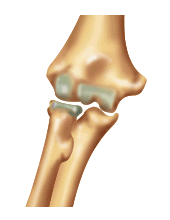The Elbow joint is a hinge joint between the humerus, the bone of the upper arm, and the two bones - the radius and ulna - which make up the forearm and end at the wrist. It allows two sorts of movement: one where the forearm moves up when the elbow is bent (called flexion) and down when the elbow is straightened (called extension), and the other to allow the hand to be turned palm up or down, called pronation and supination, which involves the outer bone of the forearm (the radius) rotating. It is contained within a capsule which is thin in front and behind, in order to allow flexion and extension, and thickened into ligaments at either side. It is flexed by muscles such as the biceps at the front of the upper arm and extended by the triceps behind. Pronation and supination of the forearm takes place mainly as a result of the action of muscles called pronators and supinators which are attached to swellings at the end of the humerus by the elbow; one either side called epicondyles. The ulnar nerve, which, among other things, supplies sensation to the inner side of the hand and the little finger, runs along the inside of the elbow: if we bump this it sends the sensation of an electric shock down the inside of the arm, which is why this is sometimes called the funny bone.
|

